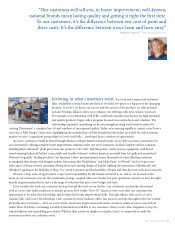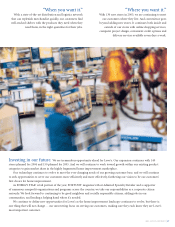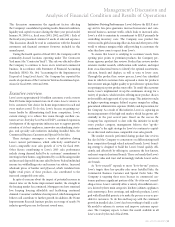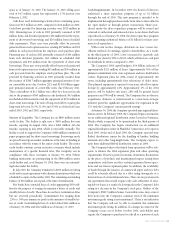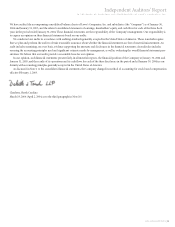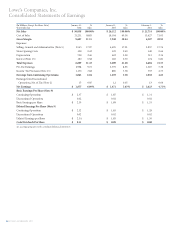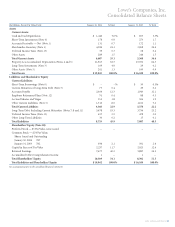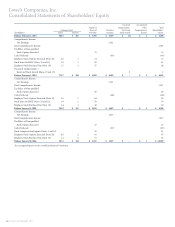Lowe's 2003 Annual Report Download - page 22
Download and view the complete annual report
Please find page 22 of the 2003 Lowe's annual report below. You can navigate through the pages in the report by either clicking on the pages listed below, or by using the keyword search tool below to find specific information within the annual report.
20 LOWE’S COMPANIES, INC.
When it comes to commercial customers, Lowe’s targets the
professionals serving the needs of homeowners. These profession-
als include remodelers, small builders, maintenance and property
managers and specialty trades, like electricians, plumbers and
landscapers. Lowe’s also wants to position itself as an alternative to
traditional supply houses and leverage core business strengths to
build the commercial business. These strengths include conven-
ience, ease of finding supplies, the EDLP strategy and specialized
commercial credit programs. The Company believes increasing
sales to commercial business customers offers the opportunity for
increasing overall sales and developing a more loyal customer base.
Lowe’s currently offers hundreds of thousands of products on
special order. Sales of these products have continued to outpace the
Company’s overall sales growth. Lowe’s focus in 2003 was on
developing new technology that will allow the Company to effec-
tively and efficiently add and maintain special order options for its
customers. The Company created an electronic sales tool that
automates the configuration, ordering, fulfillment and replenish-
ment processes for special orders, reduces errors and lead time and
increases visibility. In addition, the system will list other items cus-
tomers may need to complete their project, which should improve
customer satisfaction and increase average ticket.
Expansion and Growth Potential Management believes there is
opportunity for Lowe’s continued growth as the Company moves
forward with store expansion focused on major metropolitan mar-
kets. These metropolitan markets, which the Company defines as
populations greater than 500,000, represent a significant untapped
opportunity for Lowe’s. In fiscal 2003, Lowe’s opened its first stores
in the Chicago metropolitan market and has also announced plans
to open stores in other metropolitan markets. In addition, Lowe’s
expanded its store count in Florida and California, two of the
fastest-growing states in the U.S.
While Lowe’s growth plans are increasingly targeting larger
metropolitan areas, the Company continues to expand in smaller
markets. As a result, Lowe’s store opening plans include two proto-
types: a 116,000-square-foot (116K) store for major metropolitan
markets and a 94,000-square-foot (94K) store primarily to serve
smaller markets. This smaller prototype will provide hundreds of
additional storing opportunities in smaller markets across the
country. The store includes 94,000 square feet of retail selling space
plus an approximate 26,000-square-foot garden center, and has the
same look and feel of Lowe’s larger stores. In the 94K store, Lowe’s
has consolidated service in a number of departments and stocks
20% fewer SKUs than in the 116K stores. While there are fewer
SKUs, the 94K store still offers strong assortments with a rational
mix from opening price points to premium products. For items
not stocked in a 94K store, special order options are available to
meet customer needs. Expanding into these smaller markets is
made possible by Lowe’s logistics and distribution capabilities that
allow the Company to quickly and efficiently supply products to
these stores.
The Company currently has nine regional distribution centers
located across the United States and plans to open an additional
center in 2004 and another in fiscal 2005. The Company also has
nine flatbed distribution centers for warehousing and distributing
long-length products like lumber, plywood, ladders, and pipe.
Delivering these products on flat-bed trucks allows employees at
the stores to off-load them quickly. To support Lowe’s store expan-
sion plans, the Company is planning to open three additional
flatbed distribution centers in 2004.
The Company expects to open 140 stores in 2004 (including
approximately four relocations), increasing total square footage by
approximately 14%. To manage this expansion, the Company is
adding two more divisions in fiscal 2004, bringing the total num-
ber of divisions to five. With the addition of these two divisions,
Lowe’s will increase its number of regions from 19 to 22 and its
number of districts from 135 to 150. Lowe’s goal is to maintain a
ratio of approximately 7-8 stores per district manager and 50-60
per regional vice president. This is consistent with Lowe’s commit-
ment to ensure that its stores are executing the Company’s plans
and programs to continue to increase market share and better sat-
isfy customers with more convenience through additional store
openings and an infrastructure to support growth.
Lowe’s is also continuing to focus on improved management in
its stores. As a result, in 2003, Lowe’s changed the management
structure in its stores to provide store managers with a more struc-
tured management team and to provide employees with new
career opportunities. Lowe’s believes this focus on improved man-
agement will help attract and retain the best employees.
Critical accounting policies
and estimates.
The following discussion and analysis of the results of operations
and financial condition are based on the Company’s financial
statements that have been prepared in accordance with accounting
principles generally accepted in the United States of America. The
preparation of these financial statements requires management to
make estimates that affect the reported amounts of assets, liabili-
ties, revenues and expenses, and related disclosures of contingent
assets and liabilities. The Company bases these estimates on his-
torical results and various other assumptions believed to be rea-
sonable, the results of which form the basis for making estimates
concerning the carrying values of assets and liabilities that are not
readily available from other sources. Actual results may differ from
these estimates.
The Company’s significant accounting polices are described in
Note 1 to the consolidated financial statements. Management
believes that the following accounting policies affect the more sig-
nificant estimates used in preparing the consolidated financial
statements.
Merchandise Inventory The Company records an inventory
reserve for the loss associated with selling discontinued inventories
below cost. This reserve is based on management’s current knowl-
edge with respect to inventory levels, sales trends and historical
experience relating to the liquidation of discontinued inventory.
Management does not believe the Company’s merchandise inven-
tories are subject to significant risk of obsolescence in the near-
term, and management has the ability to adjust purchasing
practices based on anticipated sales trends and general economic



